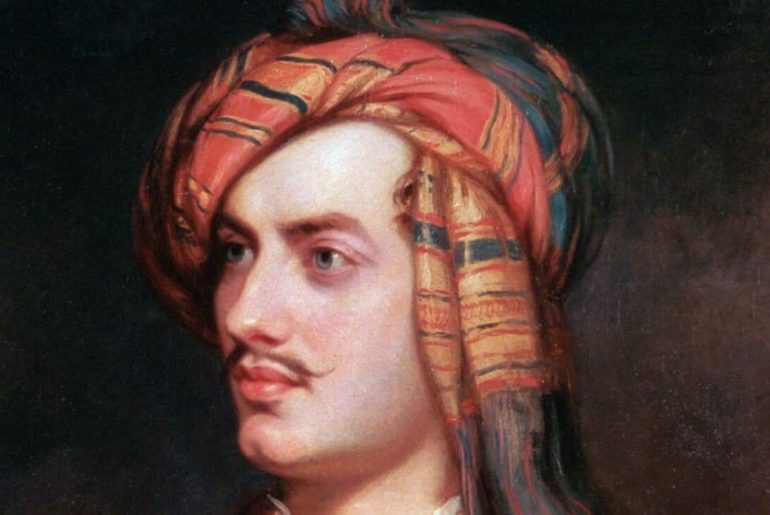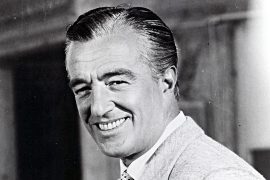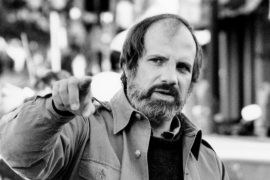GEORGE GORDON NOEL LORD BYRON belonged to the second generation of English Romantics, along with JOHN KEATS and PERCY BYSSHE SHELLEY. This second generation took a critical look at the early English romantics, WILLIAM WORDSWORTH and SAMUEL TAYLOR COLERIDGE. Last but not least, his extravagant lifestyle made BYRON the leading figure of this circle of young poets. Due to his numerous amorous affairs and an incestuous relationship with his half-sister, he was ostracized by English society. He then moved to Switzerland, where he became close friends with SHELLEY.
BYRON’S poetry reflects his predilection for the satanic as well as exotic subjects. The first two cantos of Childe Harold’s Pilgrimage, published in 1812, made him instantly famous. BYRON died of fever at the age of 36 while joining the Greek struggle for freedom against the Turks.
Biography
LORD BYRON was considered to be a personality that was as charming as it was ambivalent. He combined devotional love and excessive sensuality, the pose of world pain and genuine suffering, enthusiasm and harsh rejection. BYRON lost his father at an early age and was raised by his hysteria-prone mother. In 1798 he inherited his great-uncle’s title and fortune, which enabled him to study at Harrow and Cambridge.
Debts, his divorce and the incestuous relationship with his half-sister led to BYRON being ostracized by English society and withdrawing abroad. In 1816 he traveled first to Switzerland, where he befriended fellow poet PERCY BYSSHE SHELLEY, and then to Italy. Driven by restlessness, after a lengthy stay in Ravenna (1819–1821), he moved to work with SHELLEY in Pisa. In 1824 he decided to travel to Greece to support the Greeks in their fight for freedom against the Turks. However, he died of fever shortly after landing in Mesolongion.
Literary creation
BYRON’S poetry reflects his eventful life. After less successful early works, he wrote the first two cantos of Childe Harold’s Pilgrimage in 1812, which made him famous overnight. In it he processed the impressions of his 1809-1811 journey to the Mediterranean and the Orient. He published in quick succession several romantic verse narratives from the Orient, including The Giauor (1813), The Corsair (1814) and Lara (1814). Despite their often lax form, the poems were a great success thanks to their linguistic virtuosity and exotic subject matter.
Byron created his great works during his stay in Italy. These include:
- the Cantos III and IV of Childe Harold’s Pilgrimage (1816–1818),
- the dramatic poem Manfred (1817), a tragedy about an enigmatic guilt,
- the drama Cain (1821), the glorification of man rebelling against God,
- finally the fragmentary epic Don Juan (1819–1824, 16 cantos), which, with its art of language and irony, was conceived as a large-scale contemporary satire.
LORD BYRON himself embodies the prototype of the fun-loving, adventurous, amoral Byronian hero he conceived in the dramatic poem Manfred and the epic verse Childe Harold’s Pilgrimage. His verse novel Don Juan (1819–1824) depicts the bourgeois idea of a love marriage, which had been prevalent since the mid-18th century, as a source of incessant disappointments. BYRON, who knew how to effectively stage his outsider status, became a cult figure. His erotic escapades and his political radicalism captivated the sensationalist audience with the allure of the forbidden.
Although BYRON’s work was still influenced by classicism, as can be seen in the tragedies The Two Foscari (1821), Marino Faliero (1821) and Sardanapalus (1821), it is one of the most important contributions to English Romanticism. His poetry also left a lasting impact on European literature. French, German and Russian poets, composers and philosophers felt inspired by him, including GOETHE and ROBERT SCHUMANN. BYRON was in Germany for a long time the most famous English poet after SHAKESPEARE. GOETHE erected a monument to him in the second part of Faust (1832) in the form of Euphorion.
BYRON’S life and work was a model for Byronism, a style and lifestyle named after him that emerged at the beginning of the 19th century. The life and poetry of the Byronides was characterized by the demonstrative emphasis on culture weariness and weariness with life. Unbridled individualism was glorified; and proudly surrendered to homelessness and loneliness.
Other works (selection)
English Bards and Scotch Reviewers (1809)
The Bride of Abydos (1813)
Hebrew Melodies (1815)
The Prisoner of Chillon (1816)
Lament of Tasso (1817)
Beppo (1817)
Mazeppa (1818)
The Prophecy of Dante (1819)
Werner (1822)
Heaven and Earth (1823)
The Age of Bronze (1823)
The Island (1823)
What is Lord Byron known for?
Lord Byron was a British Romantic poet and satirist whose poetry and personality captured the imagination of Europe. Although made famous by the autobiographical poem Childe Harold’s Pilgrimage (1812–18)—and his many love affairs—he is perhaps better known today for the satiric realism of Don Juan (1819–24).
What is Byron’s most famous poem?
Don Juan is considered as the masterpiece of Lord Byron and ranks as one of the most important English long poems since John Milton’s renowned work Paradise Lost. It is a variation of the epic form and Byron himself called it an “Epic Satire”.
Why is Byron called Lord?
As a result he lacked discipline and a sense of moderation, traits he held on to his entire life. In 1798, at age 10, George inherited the title of his great-uncle, William Byron, and was officially recognized as Lord Byron.
What did Lord Byron believe in?
From his Presbyterian nurse Byron developed a lifelong love for the Bible and an abiding fascination with the Calvinist doctrines of innate evil and predestined salvation. Early schooling instilled a devotion to reading and especially a “grand passion” for history that informed much of his later writing.
Why did Byron have such a scandalous reputation?
In 1812, Byron embarked on a affair with the passionate, eccentric – and married – Lady Caroline Lamb. The scandal shocked the British public. He also had affairs with Lady Oxford, Lady Frances Webster and also, very probably, with his married half-sister, Augusta Leigh.
Why did Lord Byron write She walks in beauty?
Byron is believed to have been inspired to write the poem after seeing a woman with very good looks at a fashionable London party. His poem is, therefore, a very personal one which responded to a personal situation.
How did Lord Byron end?
In July 1823, Byron left Italy to join the Greek insurgents who were fighting a war of independence against the Ottoman Empire. On 19 April 1824 he died from fever at Missolonghi, in modern day Greece. His death was mourned throughout Britain.
What is the overall tone of this excerpt from “when we two parted” by lord byron?
The overall tone of this excerpt from “When We Two Parted” by Lord Byron is distressful.
How did lord byron die?
Later in life Byron joined the Greek War of Independence fighting the Ottoman Empire and died leading a campaign during that war, for which Greeks revere him as a folk hero. He died in 1824 at the age of 36 from a fever contracted after the First and Second Sieges of Missolonghi.
What is lord byron known for?
Lord Byron was a British Romantic poet and satirist whose poetry and personality captured the imagination of Europe. Although made famous by the autobiographical poem Childe Harold’s Pilgrimage (1812–18)—and his many love affairs—he is perhaps better known today for the satiric realism of Don Juan (1819–24).





